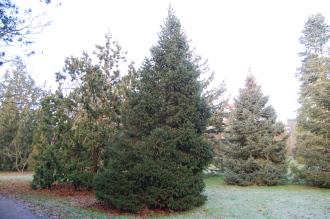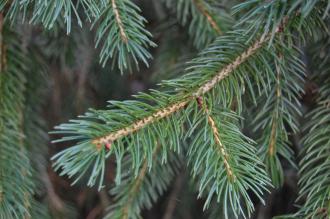
Picea schrenkiana (30/12/14, Kew Gardens, London)
Position: Full sun to partial shade
Flowering period: Spring
Soil: Moist, well drained
Eventual Height: 50m
Eventual Spread: 15m
Hardiness: 4a, 4b, 5a, 5b, 6a, 6b, 7a, 7b, 8a, 8b
Family: Pinaceae
Picea schrenkiana is a large coniferous evergreen tree with a narrow conical habit. Its dark green leaves are needle like, up to 3.5cm long and 1.5mm broad. Its trunk may achieve a diameter of up to 2m. Its dull brown bark is thickly flaking. Its male flowers are in the form of pollen cones. Its female fruit are pendulous cylindrical cones, initially purple/ green, maturing to purplish/ dull brown, up to 11cm long and 3.5cm across.
Picea schrenkiana, commonly known as Schrenk’s Spruce or Asian Spruce, is native to central Asia ans west China. In its native habitat it grows on mountain slopes in coniferous forests at an altitude of 1200m to 3500m.
The etymological root of the binomial name Picea is derived from the Latin Pix meaning ‘pitch or tar’ in reference to the Spruce trees resin. Schrenkiana is named after Alexander Von Schrenk (1816 – 1876), a Baltic naturalist.

Picea schrenkiana Leaf (30/12/14, Kew Gardens, London)
The landscape architect may find Picea schrenkiana useful as a large, upright evergreen coniferous specimen tree.
Ecologically, Picea schrenkiana seeds are attractive to some birds.
Picea schrenkiana prefers moist, fertile, well-drained soils. It tolerates most pH of soil.
Picea schrenkiana requires little maintenance.

